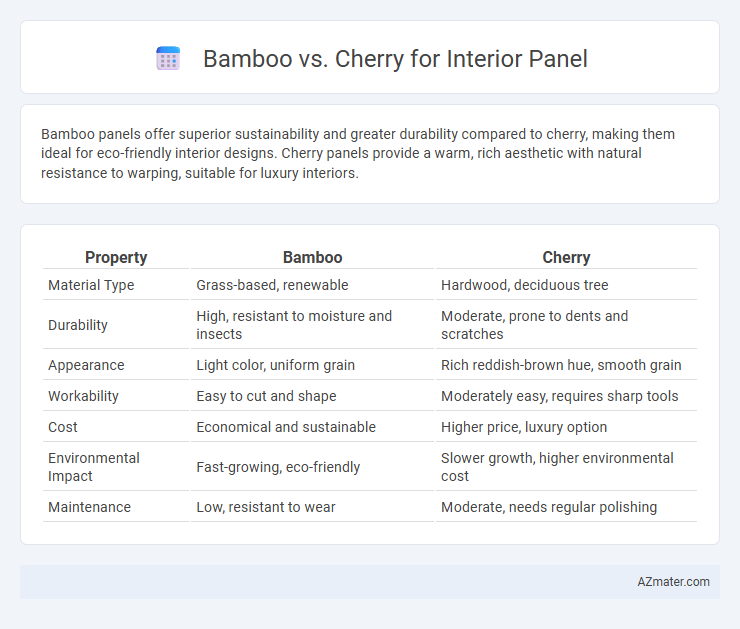Bamboo panels offer superior sustainability and greater durability compared to cherry, making them ideal for eco-friendly interior designs. Cherry panels provide a warm, rich aesthetic with natural resistance to warping, suitable for luxury interiors.
Table of Comparison
| Property | Bamboo | Cherry |
|---|---|---|
| Material Type | Grass-based, renewable | Hardwood, deciduous tree |
| Durability | High, resistant to moisture and insects | Moderate, prone to dents and scratches |
| Appearance | Light color, uniform grain | Rich reddish-brown hue, smooth grain |
| Workability | Easy to cut and shape | Moderately easy, requires sharp tools |
| Cost | Economical and sustainable | Higher price, luxury option |
| Environmental Impact | Fast-growing, eco-friendly | Slower growth, higher environmental cost |
| Maintenance | Low, resistant to wear | Moderate, needs regular polishing |
Introduction to Bamboo and Cherry as Interior Panel Materials
Bamboo offers exceptional sustainability, rapid renewability, and a unique grain pattern, making it an eco-friendly choice for interior panels with natural warmth and durability. Cherry wood is prized for its rich, reddish-brown color that deepens over time, providing timeless elegance and smooth texture ideal for high-end interior paneling. Both materials deliver distinct aesthetic qualities and varying hardness levels, influencing their suitability for different interior design styles and functional needs.
Sustainability Comparison: Bamboo vs Cherry
Bamboo offers superior sustainability compared to cherry wood due to its rapid growth rate, reaching maturity in 3-5 years versus 30-40 years for cherry trees. Its ability to regenerate from the root system without replanting minimizes soil disruption and deforestation impact. Bamboo's high carbon sequestration capacity and lower water requirements further enhance its environmental benefits over cherry for interior panel applications.
Aesthetic Appeal: Visual Differences and Styles
Bamboo interior panels offer a sleek, contemporary look with a natural grain that ranges from fine linear patterns to bold knots, enhancing modern and eco-friendly design schemes. Cherry panels present a rich, warm reddish-brown hue that darkens elegantly over time, providing a classic, luxurious aesthetic ideal for traditional or upscale interiors. The smooth texture and subtle gloss of cherry contrast with bamboo's textured, matte finish, allowing designers to select materials that best complement the desired ambiance and style.
Durability and Strength: Which Lasts Longer?
Bamboo offers exceptional durability and tensile strength, often surpassing traditional hardwoods, making it highly resistant to wear and impact in interior panel applications. Cherry wood, while known for its rich color and smooth finish, is softer and more prone to dents and scratches over time compared to bamboo. For long-lasting interior panels subjected to heavy use, bamboo provides superior longevity and structural integrity.
Maintenance and Care Requirements
Bamboo panels require regular dusting and can be cleaned with a damp cloth and mild soap to maintain their natural appearance, while avoiding excessive moisture to prevent swelling. Cherry wood demands periodic polishing and conditioning with wood oil or wax to preserve its rich color and prevent drying or cracking over time. Both materials benefit from avoiding direct sunlight and high humidity to extend the lifespan and aesthetic quality of interior panels.
Cost Analysis: Bamboo vs Cherry Panels
Bamboo panels typically cost 30-50% less than cherry panels due to faster growth cycles and lower harvesting expenses. Cherry panels offer superior durability and rich grain patterns, which justify their higher price for premium interior designs. Selecting bamboo provides a sustainable, cost-effective alternative without compromising on aesthetic appeal.
Environmental Impact and Sourcing
Bamboo interior panels offer a highly sustainable option due to bamboo's rapid growth rate of up to 3 feet per day and its ability to regenerate without replanting, significantly reducing deforestation compared to cherry panels sourced from slower-growing hardwood trees requiring decades to mature. Bamboo cultivation enhances soil health and sequesters more carbon dioxide per hectare than cherry, while cherry panel production often involves logging practices that contribute to habitat disruption and higher carbon emissions. Sourcing bamboo primarily from Asia, with expanding sustainable farms worldwide, contrasts with cherry wood's reliance on North American hardwood forests, where responsible forestry certifications are critical to minimizing environmental impact.
Installation Ease and Flexibility
Bamboo panels offer exceptional installation ease due to their lightweight structure and uniform plank size, allowing quick alignment and fastening with standard tools. Cherry panels, while providing a rich aesthetic, tend to be heavier and can require more skill to handle, especially when fitting complex patterns or custom cuts. Bamboo's natural flexibility also accommodates slight movements or irregular surfaces better than cherry, reducing the risk of panel warping or cracking post-installation.
Popular Applications in Modern Interiors
Bamboo and cherry wood are both popular choices for interior paneling due to their distinctive aesthetics and functional properties. Bamboo is favored for its sustainability, durability, and bamboo's light, natural grain, making it ideal for eco-friendly modern interiors and accent walls. Cherry wood offers rich, warm tones and smooth texture, often used in luxury cabinetry, wall panels, and elegant living spaces to create a sophisticated and timeless look.
Choosing the Right Material for Your Space
Bamboo offers exceptional sustainability and rapid growth, making it an eco-friendly choice for interior panels with a natural, warm aesthetic and excellent durability. Cherry wood provides a rich, classic appearance with smooth grain and deepens in color over time, lending sophistication to traditional and upscale interiors. Selecting between bamboo and cherry depends on factors like environmental impact, design style, maintenance preference, and budget, ensuring the material aligns with your space's functional and visual requirements.

Infographic: Bamboo vs Cherry for Interior Panel
 azmater.com
azmater.com